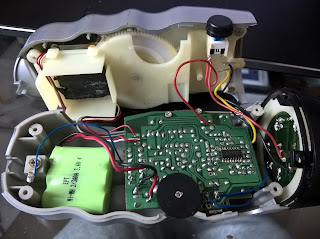The crank is a 3-phase alternator driven by two-stage gears; the output is rectified by 6 diodes. There is another diode between the bridge rectifiers and the output voltage. The FM radio IC is CD9088CB, which can operate between 1.8V and 5V, drawing about 5mA. The 8Ω 4W speak and earphone are driven by TDA2822M, a dual low-voltage power amplifier, which works down to 1.8V. The rechargeable battery pack is a 3-cell NiMH for 3.6V. Most other components are for the radio. The rectified voltage is used for direct battery charging without regulation. And the 5 parallel LEDs are powered directly with only small series resistors. All the wire connections are fragile. For a retail price of $15, we do not expect it to be a very robust construction.
The battery pack seems no longer can hold charge. We'll replace it with a small 480mAh LiPo pack (1.2 x 1.0 x 0.3"), that costs about $6 and is a little smaller than the NiMH pack (1.2x1.2x0.42") . We install a 2mm JST PH 2.0 2-Pin connector.
We bring out the voltage after the bridge rectifiers to the outside, so we can monitor the crank generator output and potentially use it to power other devices, such as other chargers. The diode to the Lipo isolates the battery to these wires, so it is relatively safe.
When unloaded, the crank generates about 5-8V at a reasonable crank rate. It can peak over 10V if cranked really fast. When it is loaded with battery, the voltages does not exceed 4.5V; after diode drop, the voltage on the battery is only about 3.8V, so it is safety for the battery . The generator can supply enough power to sustain the radio, but not the LED light.
We also connect the output to a boost regulator, that generates 5V. We use the 5V to charge a Bluetooth earphone. The generator puts out 4.4V/45mA, about 200mW. The rectified output is not very stable. If we take the output from the battery side, it's better. If we use it to charge a smartphone, the crank cannot keep up and the internal battery drains first.


No comments:
Post a Comment